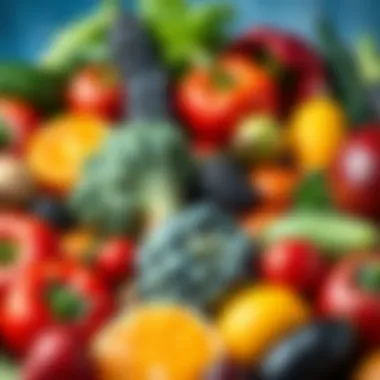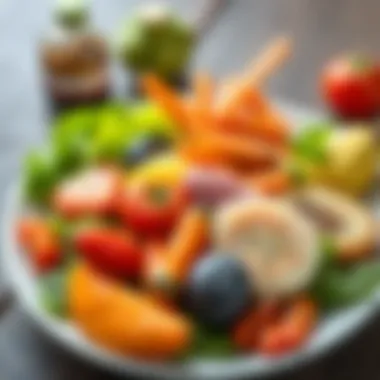Dietary Strategies Against Cancer: Insights from William Li


Intro
In the ongoing conversation around cancer prevention, the role of diet has emerged as a focal point. William Li, a physician and researcher, has brought substantial insights into this dialogue, emphasizing how what we choose to put on our plates might influence our resilience against cancer. The landscape of nutrition is not simply about sustenance; it's about empowerment. Through a deeper understanding of specific dietary strategies, individuals can cultivate habits that may enhance their health and potentially stave off disease.
One of Li's key assertions revolves around the idea that certain foods possess unique properties contributing to health protection. From the humble broccoli to vibrant berries, these foods act as potential allies in battling malignancies. The scientific foundation behind these claims is both intriguing and robust.
This article will explore the particulars of dietary classifications, methods of food preparation, and the underlying science of nutritional benefits. By connecting dietary strategies to cancer biology, those looking for ways to better their health readiness can gain a clearer perspective. Readers will walk away with actionable insights, as well as a heightened awareness of the idea that what we eat can be a strategical approach to combatting cancer.
The following sections will take a closer look at the framework of Li's nutritional philosophy, examining the various types of foods and methods that may help forge a path toward better health. Understanding these elements doesn't just broaden your nutritional palette; it can fundamentally transform how you think about your relationship with food in the quest for wellness.
Whether you are a student of biology, a health-conscious professional, or simply a curious individual seeking to learn more, this exploration promises to offer substantial depth and insight into the powerful intersection of diet and disease resistance.
Preamble to Cancer and Nutrition
Cancer remains one of the leading health challenges of our time. As it holds a firm grip over millions of lives globally, understanding its complex nature is more important than ever. In this context, the intersection of cancer and nutrition cannot be overlooked. The way we eat, the foods we choose, and even our cooking methods can play a pivotal role in shaping our health trajectory. The focus of this article is to delve into the insights from William Li, a renowned physician and researcher who advocates for dietary choices as vital tools in cancer prevention.
When exploring nutritional strategies to combat this multifaceted disease, we must consider several important elements:
- Preventive Potential: Research illustrates that certain foods possess properties which may lower cancer risk. This challenges the notion that nutrition is merely an adjunct to treatment, pushing it to the forefront of preventive healthcare.
- Biological Relevance: An understanding of the biological mechanisms by which food influences cellular behavior can offer clarity. The interactions between nutrients and cellular functions have profound implications for maintaining health and preventing disease.
- Personal Empowerment: Nutrition is a domain where individuals can take charge, showing that personal choices matter. People often seek ways to enhance their well-being, and knowledge about beneficial foods can motivate changes.
The following sections will unpack the intricate relationship between cancer and dietary practices, beginning with a deeper dive into the biological aspects of cancer.
Understanding Cancer: A Biological Perspective
Cancer begins at the cellular level, emerging when normal cells undergo transformations that lead to abnormal growth. An understanding of this biological foundation is crucial. Each cell’s lifecycle, including growth and division, can be disrupted by various factors ranging from genetics to environmental influences. However, one area that has gained momentum is the role of diet.
Cells are sensitive to what we consume—not only in terms of calories but also nutrients that act as signaling molecules. For instance, nutrients like vitamins, minerals, and phytochemicals can support healthy cellular processes, whereas a poor diet may propagate oxidative stress, inflammation, and ultimately, carcinogenic changes. We’ll explore these complex interactions in depth, shedding light on why food and cancer are often inseparable topics.
The Role of Nutrition in Health Maintenance
Nutrition's contribution to health maintenance can't be overstated. It's often said, "You are what you eat," and more than ever, this adage rings true in the realm of preventive health. Balanced nutrition fuels the body, empowering the immune system and fortifying various bodily functions.
Choices made at the dinner table have longer-lasting effects than mere satisfaction of hunger. Consider how incorporating diverse fruits and vegetables helps in providing antioxidants, which combat oxidative stress—a contributor to cancer development. Key foods like phytochemical-rich berries or cruciferous vegetables emerge as champions in this narrative.
In summary, the link between nutrition and cancer prevention is steeped in both biological mechanisms and daily choices. Acknowledging these connections sets the stage for a deeper exploration into specific food strategies that may bolster our defenses against cancer.
The Concept of Food as Medicine
The phrase "Food is Medicine" isn't just a catchphrase; it's a philosophy that emphasizes the power of dietary choices to heal and support the body. In the realm of cancer prevention, this concept holds particular significance. By choosing nutrient-dense foods, individuals not only provide essential vitamins and minerals to their bodies but also wield potential cancer-fighting properties.
This idea roots back through history, where ancient civilizations recognized the healing aspects of particular foods. Rather than addressing ailments solely with medications, there was a notable inclination toward healing through diet. This perspective continues to be validated by contemporary research, reinforcing the idea that what we consume can significantly influence our health outcomes.
Historical Perspectives on Dietary Interventions
Historically, societies have relied on their local food sources to maintain health or remedy sickness. Ancient Egyptians had a deep understanding of the medicinal properties of garlic and honey, using them not just as food, but as natural remedies for various ailments. Moving across the globe, traditional Chinese medicine espouses principles emphasizing balance in diet, highlighting foods like mushrooms for their immune-boosting capabilities.
During the Middle Ages, herbs became paramount in treatment regimens, with various plants noted for their effectiveness against illnesses. For instance, thyme was used for respiratory issues, while ginger was recognized for its digestive benefits. This long-standing recognition highlights a pivotal aspect: food, historically, was intertwined with health. People understood that the right foods could not only provide sustenance but could actively assist in combatting illnesses, including cancer.
Recent Research on Nutrition and Cancer Prevention
Today, scientific inquiry has confirmed many of these age-old beliefs. Recent studies reveal connections between certain foods and cancer prevention. For example, cruciferous vegetables like broccoli and kale have been shown to contain compounds that may inhibit tumor development. Berry consumption is frequently correlated with lower rates of several cancers, likely due to their high antioxidant content.
Research is not just about identifying which foods are beneficial; it is also about understanding how these foods impact biological processes.
"Nutritional science indicates that a balanced diet not only nourishes the body but also actively participates in immune modulation, reducing cancer risk."
The integration of advances in genomics, personalized nutrition is becoming a frontier for cancer prevention and treatment. Tailoring dietary recommendations based on individual genetic profiles could enhance the efficacy of food as medicine, optimizing the body’s unique responses. This kind of research represents a promising future, one where dietary strategies can become an integral part of comprehensive cancer care plans.
In summary, the concept of food as medicine draws from a rich tapestry of historical understanding combined with the rigor of modern research. As we explore the nutritional landscape, bridging the gap between ancient wisdom and contemporary scientific clarity, we find the same fundamental truth holds: what we eat matters—especially when it comes to reducing cancer risk.


William Li's Approach to Cancer-Fighting Foods
William Li, a physician and researcher, emphasizes a novel outlook in combating cancer through the changes we make in our diets. His approach rests on the premise that by consuming specific foods, we can potentially hinder tumorigenesis and enhance our overall health. In the previous sections, we've laid the groundwork for understanding how nutrition plays a vital role in health maintenance. Now, we build on that foundation by exploring Li's assertive stance on food as a potential medicine.
Li's methodology is multifaceted, encouraging individuals to look beyond conventional dietary recommendations. Instead of simply suggesting a wide array of foods, he focuses on particular types that have demonstrable benefits in preventing cancer. He meticulously categorizes these foods based on their properties and mechanisms, paving the way for a deeper understanding of how they interact with our biological systems.
This section will dive into the specific classifications of foods that Li promotes, examining not only their immediate benefits but also their long-term implications for individual health strategies. Let's peel back the layers on the core food groups Li identifies, spotlighting their unique characteristics and contributions to our fight against cancer.
A Survey of Key Foods and Their Properties
Fruits and Vegetables
Fruits and vegetables are at the forefront of William Li's food philosophy. They are rich in antioxidants, vitamins, and minerals that play crucial roles in promoting our health. One of the standout traits of these foods is their ability to neutralize harmful free radicals, which can damage cells and contribute to cancer development.
The colors of fruits and vegeatables are not just for show; they signal a wealth of health benefits. For instance, deep orange carrots and bright red tomatoes are packed with phytochemicals like beta-carotene and lycopene, both of which show evidence of reducing cancer risk. This vibrant variety highlights why they are celebrated choices within Li's framework.
However, it’s important to recognize that preparing these foods can impact their nutritional value. Overcooking can lead to the loss of vital vitamins. Thus, fresh, lightly steamed, or raw servings often pack the most punch in nutrition. For those on busy schedules, blending smooth soups or smoothies can ensure you still capture those important nutrients with ease.
Whole Grains
Whole grains, distinguished by their fiber content, play an integral role in maintaining a healthy gut. This aspect can't be overstated, as digestive health has been linked to a reduced risk of various cancers. Foods like brown rice, quinoa, and whole wheat pasta fit the bill as they retain the bran, germ, and endosperm—unlike refined grains.
One of the key characteristics of whole grains is their soluble fiber, which has been associated with better heart health and balanced blood sugar levels. These benefits can enable a more regulated metabolism, indirectly supporting weight management—a factor in cancer risk. Thus, they align neatly with Li's overarching goal of utilizing food to redress health imbalances.
Nevertheless, for some individuals, switching to whole grains may introduce digestive discomfort, particularly if there is a sudden increase in fiber intake. Gradual incorporation into the diet can help mitigate these issues while reaping health benefits.
Spices and Herbs
Spices and herbs serve an interesting role in Li's dietary strategy. Their unique properties not only amplify flavor but also exhibit potent anti-inflammatory and anticancer effects. For example, turmeric contains curcumin, which has shown promise in clinical studies for its protective roles against various cancer cells.
Incorporating these spices into everyday meals can be a delightful practice. A sprinkle of cinnamon on oats or a dash of ginger in tea could go a long way in supporting personal health. Key ingredients such as garlic, rosemary, and green tea are other powerful examples that Li mentions. These items aren’t just seasoning, they’re warriors against disease.
While spices generally have no significant downsides, an overzealous approach should be avoided, as some individuals may experience gastrointestinal upset. Moderation ensures that you can enjoy their unique benefits without the adverse effects.
Mechanisms of Action: How Foods Impact Health
Every food choice we make has the potential to influence our health significantly. The mechanisms through which these foods operate involve biological pathways such as angiogenesis—the formation of new blood vessels, immune modulation, and cellular detoxification. These mechanisms illustrate how specific nutrients can alter the body's cellular environment, potentially curbing the growth of malignancies.
Understanding these underlying processes is crucial for those looking to navigate dietary changes in an informed way. This knowledge empowers consumers to make choices that align with their health goals, particularly in the context of cancer prevention.
Studies show that adopting diet patterns rich in fruits, vegetables, whole grains, and spices can lower cancer risks and improve overall well-being.
As we transition to discuss practical applications of these dietary insights, it is clear that Li’s contributions provide a flexible yet robust framework for anyone wanting to enhance their dietary habits for cancer prevention.
The Five Key Strategies to Eat to Beat Cancer
Understanding how diet impacts cancer can be eye-opening and transformative. William Li highlights five key strategies that empower individuals to make informed food choices aimed at reducing cancer risk. These strategies don’t merely focus on the pleasures of eating, but delve into how select foods can influence biological processes pivotal to health.
These alliances between nourishment and our body's mechanisms can mean the difference between thriving and merely surviving. Adopting these strategies not only supports physical wellbeing but may also lead to enhanced quality of life. Each strategy, when pursued with intent, offers unique avenues through which individuals can engage proactively in their health journey, paving the way towards a life that embraces options promoting health and vitality.
Angiogenesis: The Fuel for Cancer Growth
Angiogenesis refers to the formation of new blood vessels. Cancer cells often exploit this process, encouraging the growth of their own blood supply to sustain their development. Targeting angiogenesis is crucial since it disrupts the resources that tumors require to thrive. Foods like tomatoes, berries, and garlic have properties that inhibit this process.
"Diets rich in anti-angiogenic foods may slow down tumor growth by cutting off their supply lines."
By embracing these foods, individuals can arm their bodies against the seduction of cancerous growth. Not only does this strategy spotlight nutrition as a defensive weapon, but it also emphasizes the power of prevention over reaction, placing an emphasis on dietary choices that may mitigate cancer's trajectory from the start.
Immune Enhancement through Dietary Choices
A robust immune system plays a critical role in identifying and destroying cancer cells. Nutritional choices can either bolster your immune defenses or leave you vulnerable to infiltration from diseases. Incorporating foods high in vitamins C and D, like citrus fruits and fortified dairy products, can help strengthen one’s immunity, creating a barrier against cancer onset.


Moreover, the inclusion of nutrient-dense foods provides essential antioxidants that fight oxidative stress, a known player in the development of cancer. Tunes of greens, legumes, and nuts can artificially nourish the body, enabling interlinked defenses to operate at an optimal level.
Targeting Metastasis with Strategic Nutrition
Cancer metastasis is like a chess game gone awry, where cells escape from their original site and play hide-and-seek in distant tissues. This process dramatically complicates treatment. Nutrition can either fuel or hinder this cell movement. Certain foods, like turmeric and green tea, are believed to impede tumor spread via their compounds that exhibit anti-inflammatory properties.
With determined meal planning around these strategic foods, individuals can shift the battleground, targeting the core elements that allow cancer to extend beyond its initial confines. It’s more than just healthful eating; it's about crafting a diet that actively works against cellular undisciplined behavior.
The Role of Gut Health in Cancer Prevention
The gut is often referred to as the body’s second brain, and rightly so. Its health plays a crucial role in overall immune function and, by extension, cancer prevention. Foods rich in fiber, like whole grains and legumes, feed beneficial gut bacteria, which in turn fortify the immune system. Fermented products like yogurt and kimchi introduce healthy probiotics into the system.
This strategy emphasizes the connection between gut microbiota and cancer risk. Maintaining a diverse and essential gut flora can manifest substantial protective effects against cancer development, underscoring how balanced meals nourish both physiological and microbiological landscapes.
Detoxification: Supporting Natural Body Processes
Detoxification is an essential aspect of healthcare, and the liver is the star player in this arena. Diet plays a significant role in enhancing this detoxifying ability. Foods high in fibers, like leafy greens and cruciferous vegetables, assist in the body’s natural purification processes. They help flush out cancer-causing substances while armoring the body with necessary nutrients.
Incorporating foods such as beets, carrots, and citrus fruits supports liver function and detox pathways. Reinforcing these natural systems with appropriate nutrients allows for continual cleansing and bolsters one’s defense against cancerous developments.
By understanding and embracing these five key strategies, individuals can create meaningful change in their dietary practices. Each of these strategies holds the potential for empowering choices that reinforce health, providing a foundation upon which a fortified body stands firm aginst the adversities that can accompany a diagnosis.
Practical Applications of Eating to Beat Cancer
When talking about cancer, it isn’t just a matter of treatment after diagnosis. It’s essential to find ways to support our bodies and minimize risks through effective dietary choices. Practical applications of eating to beat cancer focus on actionable steps that individuals can take to integrate these strategies into everyday life. These applications not only aim to reduce cancer risk but are also valuable for overall wellness.
Nutrition is often the unsung hero in the fight against cancer. Not all foods are created equal. Targeting specific nutrients can help bolster the body’s defenses against harmful cells. By making smarter choices, a person can transform their meals into powerful allies in maintaining health and preventing disease.
Meal Planning: Creating Cancer-Fighting Menus
Meal planning is crucial in achieving a balanced diet that emphasizes foods known to aid in cancer prevention. Creating cancer-fighting menus involves selecting ingredients that combine taste and health benefits.
- Focus on Colorful Produce: Fill your plate with vegetables and fruits that embody vibrant colors. For instance:
- Whole Grains Over Refined: Swap out white rice and bread for whole grains like quinoa and brown rice. These are rich in fiber which helps with digestion and maintains a healthy gut.
- Healthy Fats: Incorporate sources of healthy fats like avocado and nuts. They provide essential fatty acids that can suppress inflammation.
- Spices and Herbs: Don’t underestimate the power of spices. Turmeric and garlic not only add flavor but also possess anti-cancer properties due to their bioactive compounds.
- Plan Your Week: Dedicate time each week to plan your meals and snacks. Having healthy options readily available reduces the temptation to reach for convenience foods that may lack nutritional value.
- Cruciferous vegetables like broccoli and kale are packed with antioxidants.
- Berries, such as blueberries and strawberries, have high levels of flavonoids.
By making a habit of meal planning, healthier choices become the default, allowing individuals to nourish their bodies adequately.
Cooking Techniques that Preserve Nutritional Value
Even with the best ingredients, cooking methods play a pivotal role in retaining the nutrients that prevent cancer. Simple changes in how we prepare food can boost its health benefits significantly.
- Steam Instead of Boil: Steaming vegetables helps keep vitamins intact, significantly better than boiling which can leach out nutrients.
- Low-Heat Cooking: When it comes to meats, grilling or baking at lower temperatures can minimize the formation of harmful compounds.
- Raw Preparations: Incorporate raw forms of vegetables and fruits where possible. Salads or smoothies preserve enzymes and nutrients that cooking can destroy.
- Minimal Processing: Recognize that less is often more. Fewer steps in food processing can mean more nutrients retained, so aim for whole, unprocessed foods.
- Dark Chocolate Over Milk Chocolate: For something sweet, opt for dark chocolate with high cocoa content. It promotes heart health with less sugar.
In summary, both meal planning and proper cooking techniques transform the way we interact with food. These practices can lead individuals to not just adopt a diet that may help combat cancer but one that enhances overall quality of life.
"The right food choices act like shields for our health, enabling the body to defend against the threats it faces every day."
By approaching meals with intention and understanding of their potential, the vision of nutrition as a strategy to fight cancer transitions from an abstract idea to a tangible lifestyle.
Barriers to Implementing Dietary Changes
Nutrition plays a pivotal role in our overall well-being, especially when it comes to cancer prevention. Yet, the road to healthier eating habits is often fraught with challenges. Understanding these barriers is crucial for anyone interested in integrating nutrition as a formidable ally against cancer. From accessibility issues to deeply rooted cultural influences, these factors can easily deter even the most intent individual from making beneficial dietary changes.
Accessibility and Affordability of Healthy Foods
Access to healthy food is not just a matter of personal choice; it is intricately tied to socioeconomic status and geographical location. In some neighborhoods, often labeled as "food deserts," high-quality produce is as scarce as hen's teeth. Supermarkets may be few and far between, leading residents to rely on convenience stores or fast-food chains for their meals.
Additionally, the price tag on nutritious foods can be daunting. Organic vegetables, for instance, can cost an arm and a leg compared to processed alternatives packed with sugars and preservatives. This disparity can create a significant psychological barrier, making individuals feel that healthy eating is simply beyond their means.


- Health disparities arise: Populations with limited access to healthy foods are often more likely to face health issues, including higher cancer rates.
- Economic factors play a key role: As prices rise for fresh produce due to various market forces, more individuals may resort to cheaper, less nutritious options.
Efforts to bridge this accessibility gap could involve community gardens or local farmer’s markets, allowing residents to grow their own food or purchase it directly from producers at reasonable prices. Governments and organizations can also invest in subsidy programs that make fresh fruits and vegetables more reachable for low-income families.
Cultural and Behavioral Influences on Eating Habits
Eating habits are deeply ingrained societal practices, making them tough to change. Cultural influences shape what foods are considered acceptable or desirable. In some cultures, traditional dishes may rely heavily on processed ingredients or animal products, potentially conflicting with cancer prevention strategies that emphasize plant-based diets rich in antioxidants. These dietary norms often come with social validation; breaking away from them can lead to feelings of alienation.
Moreover, behavioral patterns surrounding food often develop from childhood, reinforced by family traditions and peer group values. These behavioral cues can be incredibly resistant to change. When beliefs and practices serve as the framework for social gatherings or familial bonding, suggesting a shift toward healthier choices can be perceived as an affront to cherished customs.
- Food identity is complex: It’s not just about sustenance; food often serves as an emotional anchor tied to traditions, celebrations, and even comfort.
- Education plays a crucial role: Raising awareness about the benefits of certain foods might help ease the transition and highlight the connections between what we eat and our health.
Addressing these barriers requires a multifaceted approach encompassing education, community engagement, and individual commitment to fostering a culture that prioritizes health without dismissing cultural heritage. By recognizing and understanding these challenges, individuals and communities can better navigate the path toward implementing dietary changes that can bolster cancer resistance.
"Transforming our relationship with food requires patience, education, and often a change in societal perspectives about what is desirable and acceptable to eat."
For further insights on improving accessibility and understanding cultural influences in diet, you can visit educational resources like CDC Nutrition or Harvard’s Nutrition Source. The benefits of making the leap toward healthier options are evident, with research consistently showing that a well-rounded diet can play a role in cancer prevention.
Future Directions in Nutrition and Cancer Research
The realm of nutrition and its contributions to health, especially in the context of cancer prevention, is rapidly evolving. As more studies emerge, the importance of exploring future directions in nutrition and cancer research becomes paramount. There’s an urgent need to better understand how our dietary choices impact cancer biology and the ways that innovative research can shape prevention strategies. Insightful findings can shift focus on how food serves not just as fuel, but a potential ally in our battle against cancer.
Innovative Dietary Studies on Cancer Prevention
The foundation of our understanding hinges on robust research. Recent studies delve into diverse dietary patterns, seeking patterns that correlate with decreased cancer risk. For instance, investigators have turned their attentions to plant-based diets, which have gathered considerable interest. Early research suggests that consuming a higher volume of fruits and vegetables could decrease the risk of various cancers. It's not just a numbers game; the varied compounds found in these foods, like phytochemicals and antioxidants, can play roles in cellular repair and development.
Several noteworthy examples include:
- The Mediterranean diet, rich in olive oil, whole grains, and fish, has demonstrated promising results in lowering cancer incidence.
- The DASH diet, originally intended to combat hypertension, is being reevaluated for its potential protective effects against cancer, especially colorectal cancer.
Moreover, current investigations are focusing on specific nutrients that warrant further scrutiny. A spotlight has been cast on the role of omega-3 fatty acids, found abundantly in fish like salmon and in flaxseeds, which have shown potential in reducing inflammation—an underlying factor in cancer progression.
Additionally, clinical trials are essential. They allow researchers to observe the long-term effects of dietary modifications in controlled environments. The hope is to convert findings into tangible dietary guidelines, adding layers of depth to our understanding of how nutrition operates in the complex dance of cancer biology.
Integration of Nutrigenomics: The Future of Personalized Nutrition
As we stand at the intersection of nutrition and genetics, nutrigenomics emerges as a groundbreaking field. This area studies how individual genetic variations influence responses to diet, paving the way for tailored nutritional strategies that could prevent cancer. Essentially, what works wonders for one may not hold the same benefits for another.
By integrating genetic insights with dietary information, researchers can develop specific nutrition plans designed to target individual predispositions to cancer risk. For instance, certain gene variations can affect how well one metabolizes antioxidants or particular fats, indicating a need for a personalized approach rather than a one-size-fits-all diet.
Key aspects of ongoing research include:
- Gene-environment interactions: Understanding how dietary components interact with genetic markers associated with cancer can illuminate paths to effective prevention.
- Microbiome studies: The human gut microbiome is increasingly recognized for its role in dietary response and cancer risk. Investigating how microbiome diversity relates to dietary choices is a particularly exciting avenue for research.
This move towards personalized nutrition could revolutionize cancer prevention strategies, allowing individuals to optimize their diets based on their unique genetic makeups.
The prospect of nutrigenomics is not merely theoretical. Early pilot programs are already testing personalized dietary interventions, with promising results being documented. As the body of research grows, so too does the hope that personalized nutrition can be an invaluable asset in reducing cancer prevalence and improving overall health outcomes.
Culmination: The Path Forward
The conversation around diet and cancer is ever-evolving, much like the landscape of cancer treatment and research itself. In this article, we have explored various facets of nutritional strategies that may aid in the prevention and control of cancer, all through the lens of William Li’s insights. Understanding the interaction between food and the body provides a clearer perspective on personal and public health.
Reevaluating the Role of Food in Cancer Care
The reevaluation of food's role in cancer care marks a significant shift from traditional treatment paradigms that have largely focused on pharmaceuticals or invasive procedures. Food is not just fuel; it serves as a powerful tool in influencing bodily functions at a cellular level. As Li emphasized, certain foods possess properties that inhibit cancer cell growth and encourage healing processes.
For instance, the consumption of cruciferous vegetables such as broccoli and kale can enhance detoxification pathways in the body. Moreover, spices like turmeric have garnered attention for their anti-inflammatory properties, which can potentially disrupt cancer's foothold in the body. This indicates that an informed approach to nutrition can complement conventional therapies, highlighting the necessity of a multidisciplinary perspective in cancer care.
Encouraging Informed Dietary Choices for Better Health Outcomes
The crux of combating cancer through diet lies in making informed choices. The benefits of adopting a strategic dietary plan extend beyond merely managing cancer; they contribute to overall health and well-being. Education plays a pivotal role in equipping individuals with the knowledge they need to make wise choices.
To that end, here are several actionable steps individuals can take:
- Research Nutritional Information: Websites like National Cancer Institute provide credible information on cancer-fighting foods.
- Consult Healthcare Professionals: Nutritionists and healthcare providers can tailor dietary plans specific to individual needs and cancer types.
- Stay Updated on New Research: Engage with journals and articles discussing the latest studies on nutrition and cancer—keeping abreast of findings is crucial.
As we move forward, it’s clear that fostering a culture of education around food can lead to better health outcomes. As more individuals become aware of the link between diet and health, our community can shift the narrative from fear of cancer to empowerment through dietary choices.















